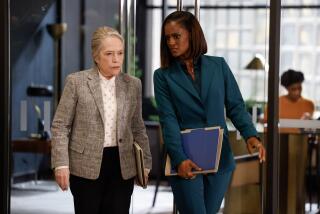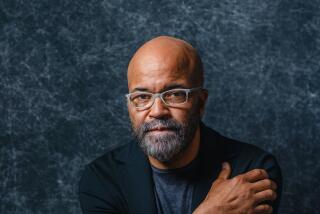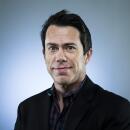Pioneering ‘Monk’ ends its run Friday
- Share via
On tonight’s series finale of USA’s “Monk,” the title detective played by Tony Shalhoub finally learns the truth about his wife’s murder. After trying to overcome his obsessive-compulsive disorder and endless phobias through eight seasons and 125 episodes -- factoids Adrian Monk himself would likely cherish -- the final chapter means a resolution, if not a triumph, for the comically tormented hero.
As a show, however, “Monk” has already beaten the odds to become one of the most significant series in TV history. It’s perhaps the prime example of the audience and industry dynamics that have reshaped scripted programming throughout this decade. When “Monk” premiered in 2002, basic cable was still largely a backwater for game shows and broadcast repeats. “Monk” helped usher in a programming renaissance that continues to this day.
TV historian Tim Brooks noted that “Monk,” with its relatively high ratings and cultural buzz, started an “original series ‘arms race’ ” with archrival TNT. That helped turned TNT’s “The Closer,” which premiered in 2005, into a massive hit, and led to a proliferation of original dramas on other networks, including FX and AMC, whose “Mad Men” has since become a cultural phenomenon.
“Now original scripted series (both dramas and comedies) are all over the cable dial,” Brooks wrote in an e-mail. “ ‘Monk’ had a lot to do, I think, with sparking that.”
Envisioned by its creator as an unlikely mix of “Columbo” and “Seinfeld,” “Monk” was the first basic cable series that saw its repeats air in prime time on not just one but two broadcast networks, ABC and NBC. That was a sharp reversal of the usual practice, where cable outlets build their schedules around old network episodes.
The message was that basic cable could produce programming that was up to broadcast standards. That may sound obvious today, but it was not necessarily an article of faith seven years ago when USA unfurled its quirky cop drama. “Monk” helped blur the line -- a line now all but invisible -- between broadcast and cable programming. And unlike pioneering premium cable shows such as “The Sopranos,” “Monk” didn’t require extensive re-editing for violence, language or nudity. It was far more family-friendly than even, say, CBS’ “CSI: Crime Scene Investigation.”
“ ‘Monk’ is very old-school. It’s a real throwback show,” said Andy Breckman, a former gag writer for David Letterman who created the series. The mysteries at the heart of each episode were “very low-tech. . . . It wasn’t about DNA or microscopes or labs or fibers. There were no computers, no sexual crimes.”
The show very nearly didn’t happen at all. Breckman and his creative partner David Hoberman originally developed the series for ABC, but had trouble casting the lead. It’s not hard to understand why. Although a brilliant detective in San Francisco, Monk is a shambling, socially awkward catalog of neuroses. He suffers from several hundred phobias, as well as OCD so disruptive that sometimes he can’t walk down the street without resisting the urge to touch every parking meter. He is haunted by his wife’s death and his desire to be reinstated on the police force, which booted him after he suffered a nervous breakdown. The role was, to put it mildly, difficult for an actor to play convincingly.
Without a compelling lead, Breckman said, the project withered away. But when ABC executive Jackie de Crinis left for a new job at USA, she took “Monk” along with her. The producers then approached Shalhoub, best known up to that point for playing the idealistic taxi driver Antonio on the ‘90s sitcom “Wings.” He had his doubts about taking on the part after reading the script.
“I had a little bit of a tricky time seeing my way into it because the character on the page seemed so impossible and annoying,” Shalhoub said in an interview. “I wasn’t sure how viewers would be able to get behind this character.”
The actor was also concerned about the OCD angle. “I wanted to make sure we weren’t going to exploit this disorder and make fun of it,” he said. “At the same time, we wanted to make sure we weren’t undercutting the inherent comedy of it. It was a tightrope walk.”
The creative team’s solution was to make the character’s mental problems both a source of his unusual gifts as a detective and, often, a comic Achilles’ heel. In one episode, for example, a suspect on a rooftop is allowed to escape due to Monk’s fear of heights. As Breckman put it, “Monk is not only the smartest man in the room, he’s also the most troubled man in the room.” Also, the writers gave Monk a compassionate nurse (Bitty Schram, who left the show in Season 3 and was replaced by Traylor Howard), who served as the viewer’s surrogate in understanding Monk’s problems.
In the meantime, USA’s decision to spend more than it usually would on a dramatic series gave “Monk” a broadcast-like feel that was often lacking in basic-cable shows up to that time. That helped make the show attractive to bosses at ABC, which ran repeats on its prime-time schedule in 2002 and 2004, as well as NBC, which did the same last year. ABC had retained the rights to rerun the show when De Crinis took the project to USA.
“Nobody thought they ever, ever would,” Bonnie Hammer, president of NBC Universal Cable, said of the idea of ABC “repurposing” the series. “It was like, ‘Right, broadcast is gonna run a cable show.’ Traditionally, it was always broadcast first, cable having a second run after the original run.”
Viewers and industry fans soon took to the show. Shalhoub was nominated for an acting Emmy for seven straight years, winning three times. For USA, “Monk” became the template for its “Characters Welcome” branding campaign, with later shows such as “Psych” and “In Plain Sight” revolving around what Hammer dubs “relatable, upbeat, slightly flawed” protagonists.
As Shalhoub sees it, “People could relate to this character because of all of these shortcomings and idiosyncrasies.
“Now you see all kinds of lead characters like in ‘House,’ where the guy is unlikable, but he’s heroic and brilliant,” Shalhoub said. “I think people are looking for that in a hero.”
More to Read
The complete guide to home viewing
Get Screen Gab for everything about the TV shows and streaming movies everyone’s talking about.
You may occasionally receive promotional content from the Los Angeles Times.







